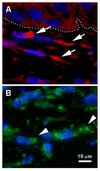Control of cell migration through mRNA localization and local translation
- PMID: 25264217
- PMCID: PMC4268399
- DOI: 10.1002/wrna.1265
Control of cell migration through mRNA localization and local translation
Abstract
Cell migration plays an important role in many normal and pathological functions such as development, wound healing, immune defense, and tumor metastasis. Polarized migrating cells exhibit asymmetric distribution of many cytoskeletal proteins, which is believed to be critical for establishing and maintaining cell polarity and directional cell migration. To target these proteins to the site of function, cells use a variety of mechanisms such as protein transport and messenger RNA (mRNA) localization-mediated local protein synthesis. In contrast to the former which is intensively investigated and relatively well understood, the latter has been understudied and relatively poorly understood. However, recent advances in the study of mRNA localization and local translation have demonstrated that mRNA localization and local translation are specific and effective ways for protein localization and are crucial for embryo development, neuronal function, and many other cellular processes. There are excellent reviews on mRNA localization, transport, and translation during development and other cellular processes. This review will focus on mRNA localization-mediated local protein biogenesis and its impact on somatic cell migration.
© 2014 John Wiley & Sons, Ltd.
Figures



Similar articles
-
Sending messages in moving cells: mRNA localization and the regulation of cell migration.Essays Biochem. 2019 Oct 31;63(5):595-606. doi: 10.1042/EBC20190009. Essays Biochem. 2019. PMID: 31324705 Review.
-
Imaging Single-mRNA Localization and Translation in Live Neurons.Mol Cells. 2016 Dec;39(12):841-846. doi: 10.14348/molcells.2016.0277. Epub 2016 Dec 29. Mol Cells. 2016. PMID: 28030897 Free PMC article. Review.
-
RNA Localization and Local Translation in Glia in Neurological and Neurodegenerative Diseases: Lessons from Neurons.Cells. 2021 Mar 12;10(3):632. doi: 10.3390/cells10030632. Cells. 2021. PMID: 33809142 Free PMC article. Review.
-
Establishing and maintaining cell polarity with mRNA localization in Drosophila.Bioessays. 2016 Mar;38(3):244-53. doi: 10.1002/bies.201500088. Epub 2016 Jan 15. Bioessays. 2016. PMID: 26773560 Free PMC article. Review.
-
Spatially and temporally regulating translation via mRNA-binding proteins in cellular and neuronal function.FEBS Lett. 2017 Jun;591(11):1508-1525. doi: 10.1002/1873-3468.12621. Epub 2017 Apr 3. FEBS Lett. 2017. PMID: 28295262 Review.
Cited by
-
Fragile X mental retardation protein in intrahepatic cholangiocarcinoma: regulating the cancer cell behavior plasticity at the leading edge.Oncogene. 2021 Jun;40(23):4033-4049. doi: 10.1038/s41388-021-01824-3. Epub 2021 May 20. Oncogene. 2021. PMID: 34017076 Free PMC article.
-
The Quaking RNA-binding proteins as regulators of cell differentiation.Wiley Interdiscip Rev RNA. 2022 Nov;13(6):e1724. doi: 10.1002/wrna.1724. Epub 2022 Mar 17. Wiley Interdiscip Rev RNA. 2022. PMID: 35298877 Free PMC article. Review.
-
Hitting the mark: Localization of mRNA and biomolecular condensates in health and disease.Wiley Interdiscip Rev RNA. 2023 Nov-Dec;14(6):e1807. doi: 10.1002/wrna.1807. Epub 2023 Jul 2. Wiley Interdiscip Rev RNA. 2023. PMID: 37393916 Free PMC article. Review.
-
Protrusion-localized STAT3 mRNA promotes metastasis of highly metastatic hepatocellular carcinoma cells in vitro.Acta Pharmacol Sin. 2016 Jun;37(6):805-13. doi: 10.1038/aps.2015.166. Epub 2016 May 2. Acta Pharmacol Sin. 2016. PMID: 27133294 Free PMC article.
-
Differential Myosin 5a splice variants in innervation of pelvic organs.Front Physiol. 2023 Dec 12;14:1304537. doi: 10.3389/fphys.2023.1304537. eCollection 2023. Front Physiol. 2023. PMID: 38148903 Free PMC article.
References
-
- Weijer CJ. Collective cell migration in development. J Cell Sci. 2009;122:3215–3223. - PubMed
-
- Ohata E, Takahashi Y. [Dynamic cell migration during development] Tanpakushitsu Kakusan Koso. 2006;51:742–746. - PubMed
-
- Locascio A, Nieto MA. Cell movements during vertebrate development: integrated tissue behaviour versus individual cell migration. Curr Opin Genet Dev. 2001;11:464–469. - PubMed
-
- Franze K. The mechanical control of nervous system development. Development. 2013;140:3069–3077. - PubMed
Publication types
MeSH terms
Substances
Grants and funding
LinkOut - more resources
Full Text Sources
Other Literature Sources

